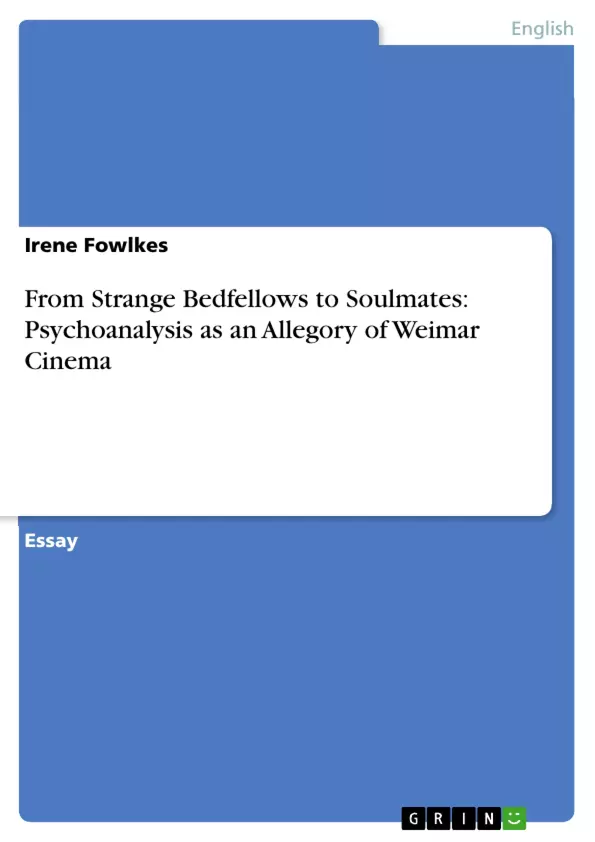application of the science of psychology to the study of culture. The screening of the
movie Secrets of a Soul on the birthday of the founding father of psychoanalysis Sigmund
Freud in Berlin demonstrated the initial point of convergence between one of the most
important and influential psychological theories of the 20th century and film production.
Although Freud did not consider the cinematic medium as appropriate to fully explain the
abstract concepts of psychoanalysis, which the film attempts by means of a case study
concerning a patient’s treatment, there apparently occurred some sort of transference process
between the analyst and the artists. Thus, by mutually reinforcing each other, both discourses
gained legitimacy making it worthwhile to further examine this relationship.
G.W. Pabst’s 1926 film, Secrets of a Soul (Geheimnisse einer Seele), is one
such encounter, a chapter in the still unwritten and untheorized metahistory
of psychoanalysis and cinema.
This paper aims to make a contribution to that metahistorical text, proposing a combination
of abstract analytical thought and popular entertainment during the Weimar Cinema period.
In agreement with the notion, that “the ready appeal of cinema as an analogy for mental
processes brings about the danger of the loss of the specificity of psychoanalytic
understanding”3, I will not try to equate the two discourses, but rather follow two objectives:
First, utilize psychoanalytic theory as an instrument for strategic interpretation of the story /
plot of a particular film and second, attempt to crystallize out the way it corresponds with
cinematic representation. In regards to the latter aspect I operate under the assumption, that
the creative process of film making entails a big part of the unconscious and thus lends itself
to psychoanalytic interpretation. Although in contrast to Secrets of a Soul it does not deal
with the method of psychoanalysis directly, I chose the movie The Cabinet of Dr Caligari for
this paper, because I suppose that it contains various elements of the conceptual framework
of the theory which comes about in narrative and visual terms. Primarily leaning onto a core
text in the history of German film, written by the Marxian representative Krakauer, I will
thus treat the movie as an allegory of psychoanalysis in general and try to see to what extent
it can be considered a reflection of the so called collective unconscious.
[...]
Inhaltsverzeichnis (Table of Contents)
- 1. Introduction
- 1.1 Psychoanalysis as an instrument of interpretation
- 1.2 Psychoanalysis as an allegory of Weimar Cinema
- 1.3 Psychoanalysis as a model of cinematic fiction
- 2. Overview
- 2.1 Main approaches to Weimar Cinema in critical theory
- 2.2 Position of psychoanalysis in context of the secondary literature
- 2.3 Explanation of psychoanalytic terminology
- 3. Body
- 3.1 Plot summary and psychoanalytic interpretation in the context of Krakauer’s History of the German film
- 3.2 Exploration of psychoanalysis as a model of cinematic representation with reference to Lotte Eisner’s The Haunted Screen
Zielsetzung und Themenschwerpunkte (Objectives and Key Themes)
This paper aims to contribute to the metahistory of psychoanalysis and cinema by exploring the relationship between psychoanalytic theory and Weimar Cinema. It has two main objectives: first, to utilize psychoanalytic theory to interpret the plot of a specific film (The Cabinet of Dr. Caligari); and second, to examine how psychoanalytic concepts correspond with cinematic representation, particularly within the context of German Expressionism.
- The application of psychoanalytic theory as a tool for interpreting film narratives.
- The exploration of the relationship between psychoanalytic concepts (e.g., the unconscious, the Id, Ego, and Superego, defense mechanisms) and cinematic representation.
- The analysis of German Expressionism as a visual manifestation of psychoanalytic concepts.
- The examination of The Cabinet of Dr. Caligari as an allegory of psychoanalysis and a reflection of the collective unconscious.
- The exploration of the convergence of psychoanalytic and cinematic discourses in Weimar Cinema.
Zusammenfassung der Kapitel (Chapter Summaries)
Introduction: Introduces the convergence of psychoanalysis and film, focusing on Secrets of a Soul and the potential for psychoanalytic interpretation of cinema. The paper's objectives are outlined: using psychoanalysis as an interpretive tool and examining its correspondence with cinematic representation, using The Cabinet of Dr. Caligari as a case study.
Overview: Provides an overview of critical approaches to Weimar cinema, highlighting the Frankfurt School and Lacanian perspectives. Key psychoanalytic concepts, including the Id, Ego, Superego, defense mechanisms, and the collective unconscious, are explained, laying the groundwork for the subsequent analysis.
Body (3.1): Summarizes The Cabinet of Dr. Caligari's plot and offers a psychoanalytic interpretation based on Krakauer's work. It connects the film's characters and narrative to the Id, Ego, and Superego, interpreting the film as an allegory for the German psyche during the Weimar Republic.
Body (3.2): Examines the visual aspects of The Cabinet of Dr. Caligari through the lens of German Expressionism and its relation to psychoanalytic concepts. It discusses the film's visual style, its use of symbolism, and its evocation of anxiety and terror as manifestations of unconscious processes.
Schlüsselwörter (Keywords)
Weimar Cinema, Psychoanalysis, German Expressionism, The Cabinet of Dr. Caligari, Collective Unconscious, Id, Ego, Superego, Defense Mechanisms, Cinematic Representation, Film Interpretation, Symbolic, Imaginary, Sublimation.
- Quote paper
- Irene Fowlkes (Author), 2005, From Strange Bedfellows to Soulmates: Psychoanalysis as an Allegory of Weimar Cinema, Munich, GRIN Verlag, https://www.grin.com/document/125056



